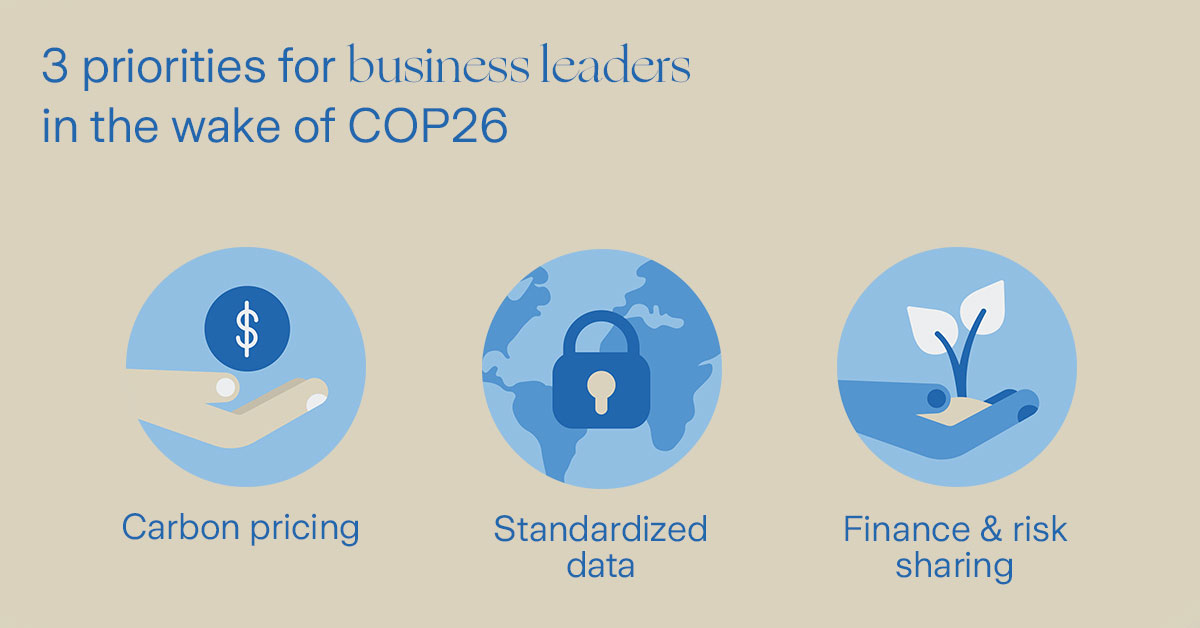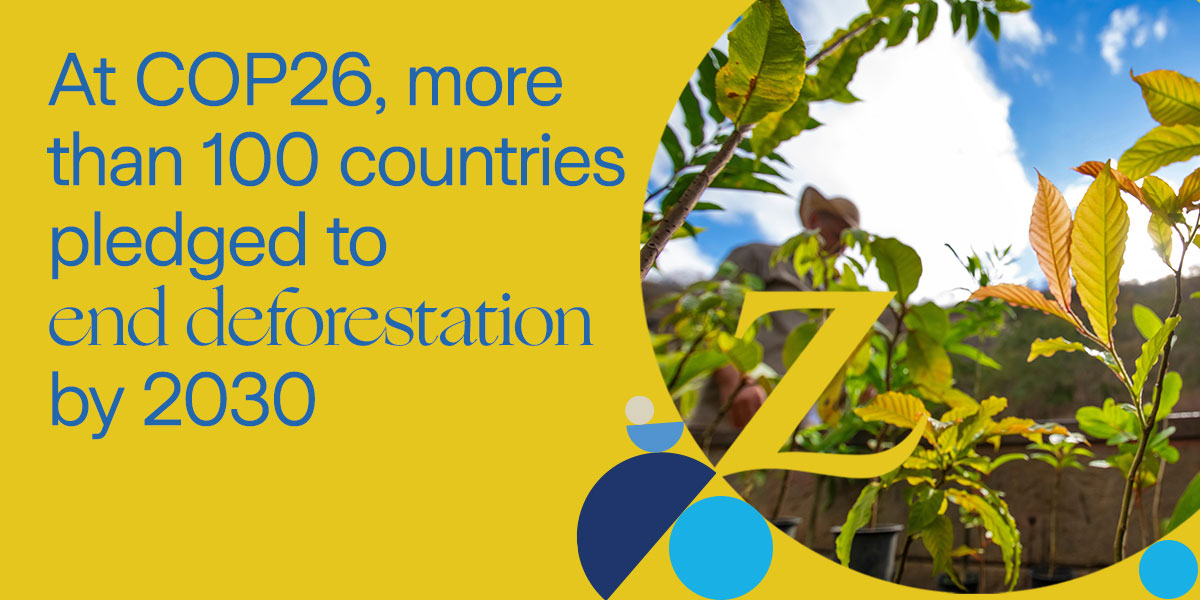3 priorities for business leaders in the wake of COP26
Climate resilienceArticleNovember 16, 20217 min read
This year’s COP26 climate summit underscored the urgency of the action needed as climate change intensifies. We break down what happened in Glasgow and outline the areas that will be top of the agenda for business leaders.
COP26, the UN’s conference on climate change that was held recently in Glasgow, Scotland, may not have achieved all of its goals, but it did force everyone to sit up and pay attention to the seriousness and urgency of the climate change crisis.
The conference has dominated newspaper headlines and TV bulletins around the world, with John Kerry, the U.S. Special Presidential Envoy for Climate, observing that: “There’s a dynamic setting into this COP. It’s different, there’s more energy, more focus, more sense of urgency than I’ve seen at any of these meetings ever.”
But the deal signed at COP26, called the Glasgow Climate Pact, was overshadowed by coal. A commitment to ‘phase out’ coal that was included in earlier negotiation drafts was watered down to ‘phase down’ coal following opposition from India and China.
This last-minute change to the text left many disappointed, but it should not mask the fact that the Glasgow Climate Pact is the first ever climate deal to explicitly plan to reduce coal – a significant achievement. And amid all the politicians’ handshaking, backslapping and speechifying, there were other landmark environmental announcements that showed real progress from COP26. These include:
- India pledging to reach net-zero emissions by 2070, following China’s announcement last year that it’s aiming to achieve net-zero by 2060. India also announced that 50 percent of its energy will come from renewable sources by 2030. This means that all the world’s major carbon emitters have now agreed to phase out fossil fuels.
- More than 100 countries pledging to end deforestation by 2030. Between them, these countries, which crucially include Brazil, home to the Amazonian rainforest, account for 85 percent of the world’s forests.
- More than 100 countries agreeing to a 30 percent cut in methane emissions by 2030. Methane is thought to be responsible for around 30 percent of historic global warming. Signatories include six of the planet’s 10 biggest methane emitters.
- More than 40 countries agreeing to phase out coal, with major coal users such as Poland, Chile and Vietnam joining the Powering Past Coal Alliance and committing to end all investment in new coal power.

These ambitious targets and pledges do represent significant steps forward on the road to net-zero. However, positive and admirable though they undoubtedly are, they come with some caveats. The first is that COP26’s most ambitious announcements were all aimed at deadlines decades in the future. Whereas across each of these environmental areas – from ending deforestation to reducing methane emissions – urgent action is required in the here and now. The second caveat is that governments’ net-zero pledges generally focus our attention on what must be achieved in the future – the ultimate goal or ambition – rather than the more difficult and complex question of how we are planning to get there.
For this reason, many governments, global bodies and corporations are now looking at what it will take in practical terms to achieve the headline-grabbing pledges announced at COP26. In short, what does the world need to do and put in place now in order to achieve net-zero? Here are three important practical initiatives that can help provide that platform.
1. Carbon pricing
Simply put, carbon pricing is a financial mechanism that helps both countries and companies lower their emissions. It does this by making using fossil fuels more expensive through tariffs and taxes, while also making cleaner, renewable energy sources cheaper and more cost-effective.
Article 6 of the Paris Agreement, which covers the rules on how countries can reduce their emissions using international carbon markets, was never agreed in the French capital. But finally, after six years of discussions, the Paris rulebook – guidelines for how the Paris Agreement is delivered – was agreed in Glasgow. This includes Article 6, which establishes a robust framework for countries to exchange carbon credits through the UN.
The International Trading Emissions Trading Association (IETA) says it will provide “clear accounting guidance for emissions trades between countries, and launch a new crediting mechanism that will give market access to all countries interested in attracting green investment through the global carbon market.”

The new internationally-controlled standards – that include provisions to avoid double-counting of the same emissions claimed by multiple companies or countries – could unlock billions of dollars of investment in carbon reduction projects around the world.
Kelley Kizzier, Vice President for Global Climate at non-governmental group Environmental Defense Fund, says the agreement on Article 6, “provides the rules necessary for a robust, transparent and accountable carbon market to promote more and faster climate ambition and create a further avenue for finance flows from developed to developing countries.”
2. Standardized data
It is encouraging to see businesses and the financial sector as a whole taking an increasingly active role in combating climate change. As John Kerry said at COP26: “There is a [new] critical component… for the first time, and in a massive way, the private sector is at the table and, frankly, leading in the way that even some governments are not.”
But for companies and investors to be productively involved, there needs to be a globally consistent and transparent approach to the definition and reporting of sustainability data. Without it, it is impossible for investors to objectively measure a company’s environmental credentials, which also increases the risk of greenwashing.
This is why one of the most significant moments at COP26 was the announcement of the International Sustainability Standards Board, whose role it will be to set out a comprehensive global baseline of sustainability disclosure standards. It is precisely this kind of shared framework of financial regulation and standardized data that will allow investments in green companies and projects to have a measurable and therefore meaningful impact.
3. Finance and risk sharing
The role the private sector can play in the race to achieve net-zero is hard to overestimate. Indeed GFANZ, a global coalition of leading financial institutions launched by Mark Carney, the UN’s Special Envoy for Climate Action and Finance, which is committed to decarbonizing the global economy, estimates that its members are currently responsible for assets worth over USD 130 trillion – which is nearly 50 times bigger than the annual output of the entire UK economy.
However, the public sector also requires significant support and encouragement from governments, so that both the costs and risks of investing in sustainable initiatives are spread as widely as possible.
As the creation of GFANZ demonstrates, private finance is already flowing towards sustainable investment, but governments will also need to provide financial incentives. One way they are already doing this is by issuing ‘green bonds’ that are specifically designed to support climate-related and other environmental projects. It’s an encouraging example of how governments and the private sector can work together to facilitate the flow of investment to support the climate transition. It is only by making this kind of green investment transparent and scalable that the world can hope to achieve the ambitious environmental targets announced at COP26.




